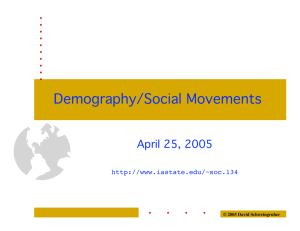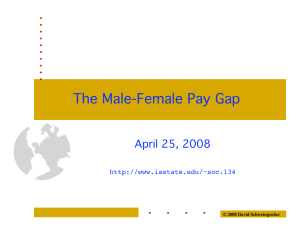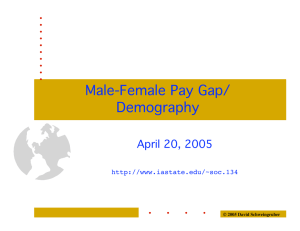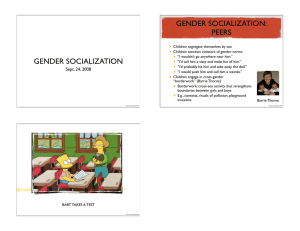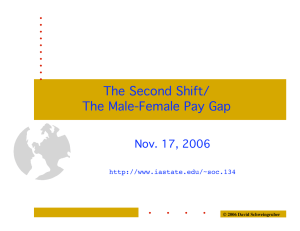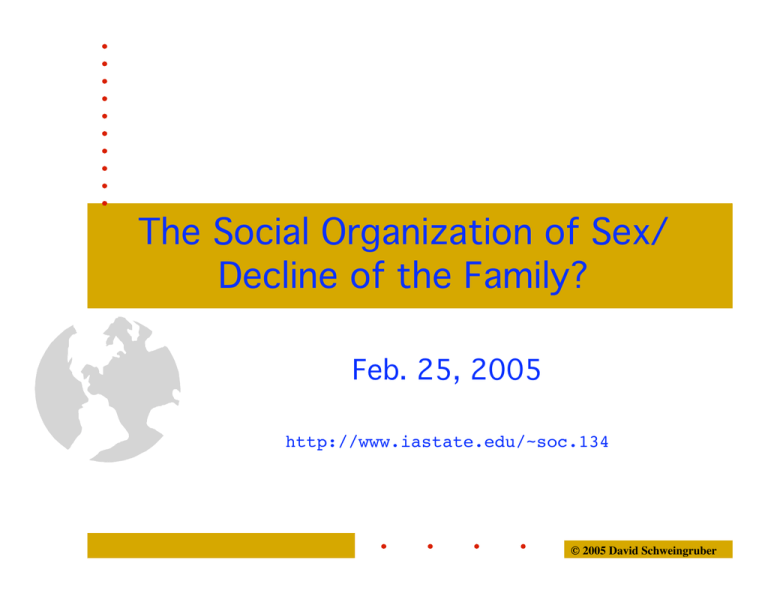
The Social Organization of Sex/
Decline of the Family?
Feb. 25, 2005
http://www.iastate.edu/~soc.134
© 2005 David Schweingruber
Frequency of sex in past 12 months
Men
4 or
more
times a
week
(8%)
Not at
all
(14%)
2 or 3
times a
week
(26%)
A few
times
per year
(16%)
A few
times
per
month
(37%)
Source: Michael, et al. 1994. Sex in America. Little, Brown.
4 or
more
times a
week
(7%)
2 or 3
times a
week
(30%)
Women
Not at A few
all
times
(10%) per year
(18%)
A few
times
per
month
(36%)
©©2005
2000David
DavidSchweingruber
Schweingruber
Have sex at least a few times
or more per month
Frequency of sex by type of union
100%
90%
80%
70%
60%
50%
40%
30%
20%
10%
0%
92% 91%
86% 86%
52% 44%
Noncohabitating
Source: Michael, et al. 1994. Sex in America. Little, Brown.
Men
Women
Cohabitating
Married
©©2005
2000David
DavidSchweingruber
Schweingruber
Have sex at least a few times or more
per month
Frequency of sex by age
90%
80%
70%
60%
50%
40%
Men
Women
30%
20%
10%
0%
18-24
25-29
Source: Michael, et al. 1994. Sex in America. Little, Brown.
30-39
40-49
50-59
©©2005
2000David
DavidSchweingruber
Schweingruber
Percent "extremely" or
"very" satisfied with sexual
relationship
Sexual satisfaction by type of union
100%
90%
80%
70%
60%
50%
40%
30%
20%
10%
0%
84.4% 75.6%
87.4% 84.8%
78.2% 71.0%
Noncohabitating
Physical pleasure
Emotional satisfaction
Source: Michael, et al. 1994. Sex in America. Little, Brown.
Cohabitanting
Married
©©2005
2000David
DavidSchweingruber
Schweingruber
Measuring homosexuality
Kinsey emphasized continuum of sexuality
Lifetime male-male sexual contact (37%)
10% had only homosexual experience during any three-year
period between 16-55
4% reported sex only with men since adolescence
NHSLS studied three aspects of homosexuality
Desire: same-sex sexual attraction
Behavior: having same-sex sex
Identification
Source: Michael, et al. 1994. Sex in America. Little, Brown.
©©2005
2000David
DavidSchweingruber
Schweingruber
Source: Michael, et al. 1994. Sex in America. Little, Brown.
Sex since
puberty
Sex since 18
Sex in past 5
years
Sex in past
12 months
Identification
Men
Women
Same-sex sex
appealing
10%
9%
8%
7%
6%
5%
4%
3%
2%
1%
0%
Same sexattraction
Different measures of homosexuality
©©2005
2000David
DavidSchweingruber
Schweingruber
Interrelations of components of homosexuality
Men (10.1%)
Women (8.6%)
Desire
59%
13%
6%
0%
1%
24%
1%
Behavior
22%
15%
Behavior
13%
Desire
44%
0%
Identity
2%
Identity
0%
Source: Michael, et al. 1994. Sex in America. Little, Brown.
©©2005
2000David
DavidSchweingruber
Schweingruber
Is the American family declining?
Evidence of decline: divorce, single-parent families,
unsupervised children
However, there has been no golden age of the
American family. Each generation has believed the
family was declining.
• Children in the 19th Century were more likely to live in
single-parent families than today
• In 1900, 20% of children lived in orphanages
• In 1900, rates of alcohol & drug abuse, school dropouts and
domestic violence were higher
• Extended family rates have never risen above 20%
Source: Coontz, S. 1992. The Way We Never Were. Basic Books.
©©2005
2000David
DavidSchweingruber
Schweingruber
What about the 1950s?
1950s weren’t as we remember them
• < 60% of children lived in “traditional” family
• Many women were unhappy with non-work role
• Blacks faced worse discrimination than later decades
1950s family was “experimental,” not
“traditional”
• Dad-works, mom-stays-home model began in 19th
century
• Women began entering office jobs in 1920s
• After WWII many women left factories for home
• But female labor market participation began rising
again in 1950s
Source: Coontz, S. 1992. The Way We Never Were. Basic Books.
©©2005
2000David
DavidSchweingruber
Schweingruber
What about the 1950s?
What was different about the 1950s?
• Divorce rate, high during Depression & WWII, dropped
• Age of marriage fell to 100-year low
• Birth rate soared (Baby Boom)
What led to the 1950s family experiment?
• Women were forced out of jobs after WWII
• Economic growth and government programs allowed for prosperity
with one wage earner
• Ideal of dad-works, mom-stays-home family established
• New ideal was supported by experts and media
Source: Coontz, S. 1992. The Way We Never Were. Basic Books.
©©2005
2000David
DavidSchweingruber
Schweingruber


